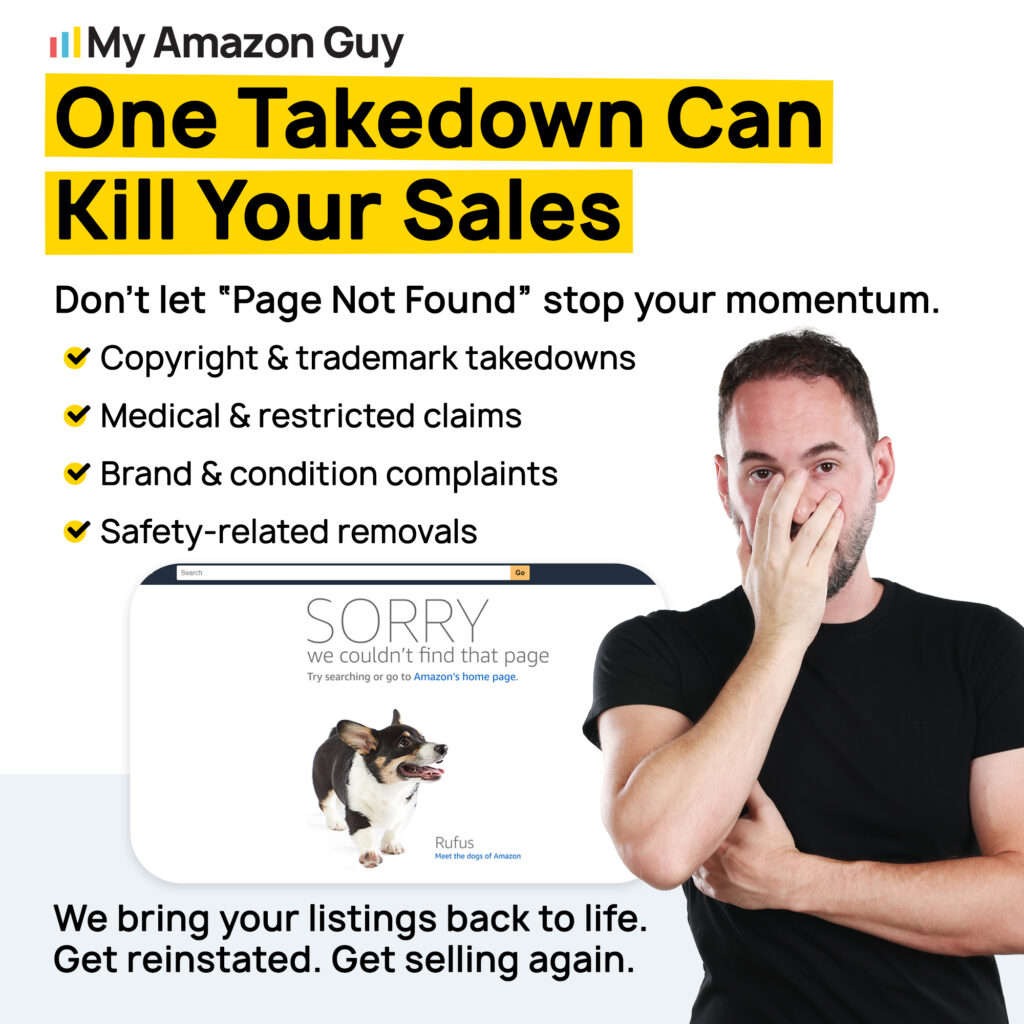
Are you aware that Amazon is spying on e-commerce sites owned by Amazon sellers? If your website content isn’t consistent with your Amazon listings, now’s the time to fix it, because this inconsistency could lead to warnings, suppressed listings, or even account flags.
Many sellers use their own e-commerce sites to say or promote things they can’t on Amazon, like stronger claims, special discounts, or unique bundles. But this freedom often creates mismatched information that Amazon’s AI can easily detect, raising red flags for potential policy violations.
Having a clear, unified compliance strategy is now critical to protecting your listings and maintaining your brand’s reputation. Sellers need to make sure their pricing, product claims, and brand messaging align perfectly across every channel they sell on.
This blog talks about how Amazon is spying on e-commerce sites to monitor seller activity, making it crucial for brands to maintain consistency and compliance across all platforms. Our Amazon agency will also discuss how this shift impacts listings, product data accuracy, and what sellers can do to stay protected while still running independent e-commerce stores.
Table of Contents
Avoid Costly Mistakes Before It’s Too Late
Your website should boost your Amazon sales, not hurt them. We’ll show you how to align both for consistent growth.
Amazon’s AI Is Tracking Your E-commerce Site
Amazon’s AI is actively crawling e-commerce websites owned by sellers, scanning for pricing, claims, and product details that don’t match what’s listed on Amazon. The problem? Even a small inconsistency between your site and your Amazon listing could trigger compliance alerts, product suppressions, or even a full listing suspension.
This AI system was designed to ensure product accuracy and policy compliance, but it’s also causing concern among sellers who use their own websites for more flexible marketing. If your e-commerce site says something Amazon doesn’t allow, or even different pricing, the system can flag your listing automatically without human review.
What Happens When Amazon Flags Your E-Commerce Site
When Amazon’s AI detects discrepancies between your e-commerce site and your Amazon listings, it will start an automated compliance process. Once you’re flagged, your listings and even your account health can take a serious hit.
- Your product may instantly lose visibility or get delisted from search results.
- Amazon can suppress your listing, making it unbuyable until the issue is resolved.
- You’ll likely receive a “policy violation” warning that affects your Account Health Rating.
- If you sell in sensitive categories (like supplements or cosmetics), you might face full listing suspension.
- Inconsistent content could trigger delays in approvals for ads or new listings.
- Repeat violations can lead to longer investigations or stricter oversight on all your future listings.
10 Seller Mistakes That Trigger Amazon AI to Flag Your Site
With how strict Amazon has become about compliance and product data accuracy, sellers should be treating their e-commerce websites like an extension of their Amazon storefront. In fact, around 18% of active Amazon sellers face at least one compliance-related restriction or suspension each year, and with Amazon’s AI now tracking e-commerce sites, those risks are only increasing.
1. Making Unverified Health or Medical Claims
Claims like “clinically proven”, “treats anxiety”, or “FDA-approved” on your e-commerce site can trigger Amazon’s AI to flag your listings. Even if your Amazon page is compliant, external claims are now used as evidence for takedowns, especially in supplements and cosmetics.
2. Showing a Lower Price on Your Website Than on Amazon
Amazon’s bots constantly compare pricing across platforms. If your e-commerce site lists the same product for cheaper, Amazon can issue a “High Price Error”, suppress your Buy Box, or delist your product entirely.
3. Using Prohibited Phrases or Keywords on Your Website
Amazon bans certain marketing phrases like “miracle cure”, “medical grade”, or “guaranteed results”. If these appear on your e-commerce site but not on your listing, AI might still connect the dots and flag the listing for inconsistent or misleading advertising.
4. Displaying Non-Compliant Product Images
Your website may include lifestyle or promotional images that violate Amazon’s product image policies, such as showing claims on packaging or featuring text overlays. Amazon’s visual recognition AI scans these and may flag listings that appear inconsistent.
5. Making Conflicting Product Claims
If your website says a product “lasts 12 months” while your Amazon listing says “6 months”, Amazon’s system will detect the inconsistency. This discrepancy can result in your listing being suppressed for “false or misleading product information”.
6. Offering Promotions or Discounts Not Reflected on Amazon
Advertising a “Buy One Get One Free” or “50% off” deal on your site that doesn’t match your Amazon listing can be seen as unfair pricing or customer manipulation. Amazon can penalize listings that appear to mislead customers about value.
7. Selling Unapproved or Restricted Variants on Your Website
If your website promotes versions of a product (e.g., higher strength supplements or unapproved materials) that don’t exist on Amazon, the AI might flag your entire ASIN family for compliance review.
8. Using Customer Reviews or Testimonials with Non-Compliant Claims
If your website features reviews that make prohibited claims (like “this cured my eczema”), Amazon’s AI can use that language as evidence of non-compliance. It doesn’t matter if the claim came from a customer; it’s still attributed to your brand.
9. Using Misleading Comparison Charts
If you compare your product to competitors or make superiority claims (“#1 best skin serum” or “twice as strong as X”), Amazon may flag the listing as making unverifiable comparative claims.
10. Failing to Update Outdated or Deprecated Content
Amazon’s AI stores cached versions of your site, meaning old or outdated product descriptions can still trigger violations later. If you rebrand or reformulate, make sure your e-commerce content is updated across all URLs.
Stay Ahead of Amazon’s AI
Amazon’s algorithms are getting smarter—make sure your business is smarter too. Let our experts guide you through compliance and optimization.
How to Stop Amazon’s AI from Flagging Your E-commerce Site
Amazon’s AI may be monitoring your e-commerce site, but that doesn’t mean you’re powerless. There are proactive ways to safeguard your listings and maintain consistency across every channel where your brand shows up.
By building a unified compliance strategy, you reduce the risk of getting flagged while maintaining your brand voice, creativity, and authenticity. These ten strategies will help you stay compliant and build long-term trust with both Amazon and your customers.
1. Audit Your Website for Amazon Compliance
Start by reviewing every word, image, and claim on your website as if Amazon’s compliance team were looking at it, because now, they are. Audit your product titles, descriptions, and banners against Amazon’s restricted claims and advertising guidelines.
Implement a monthly site audit process using a checklist that mirrors Amazon’s policies for health claims, pricing, and prohibited terms. Treat your website as an extension of your Amazon storefront; what you say off-platform now matters just as much as what’s live on Amazon.
2. Standardize Product Claims Across Platforms
If your product “reduces stress” on your website but only “promotes relaxation” on Amazon, that’s an inconsistency waiting to be flagged. Amazon’s AI is trained to detect mismatched claims between your listing and external sources.
Create a single, approved library of product descriptions that your team uses for all marketing channels, Amazon, your e-commerce site, social media, and ads. This way, every message is unified, compliant, and easy to update when regulations change.
3. Match Pricing Between Amazon and Your E-commerce Store
Amazon’s AI bots scan for price discrepancies, and if your site lists lower prices, you can lose Buy Box eligibility or trigger “High Price Error” warnings. Even small mismatches raise red flags.
Use automated pricing tools or sync platforms like ChannelAdvisor or Sellbrite to maintain real-time parity. If you offer special discounts on your site, use promo codes or gated access to avoid public visibility that Amazon can crawl.
4. Avoid Prohibited or Risky Terminology
Phrases like “medical grade”, “clinically tested”, or “FDA approved” might perform well in search, but they’re compliance landmines. Even if these words aren’t on your Amazon page, AI matching can still flag your listings for using them elsewhere.
Replace risky claims with compliant, benefit-driven language, such as “gentle formula” or “trusted by professionals”. If you need to communicate certifications, make sure you have supporting documentation that Amazon can verify.
5. Keep Product Images Consistent and Policy-Compliant
If your e-commerce site uses enhanced visuals or packaging images with unapproved claims, Amazon’s AI could link those back to your ASIN. The system can detect discrepancies between what’s shown on Amazon and what’s on your brand website.
Use one master image set for all platforms, designed according to Amazon’s standards: no text overlays, promotional graphics, or misleading before-and-after photos. This ensures uniformity and eliminates visual red flags.
6. Sync Packaging, Labeling, and Descriptions
Amazon’s compliance AI now scans packaging and label details referenced online. If your website description says “now with new formula”, but your product images on Amazon show the old one, that inconsistency can cause confusion.
Regularly update both your Amazon listings and your site when you make packaging or formula changes. Keep a product update log to ensure every adjustment is reflected across all channels at the same time.
7. Align Promotions and Offers
Amazon takes issue with “misleading promotions”. For example, if you’re offering 30% off on your website but not on Amazon, the platform may interpret that as an unfair competitive advantage.
Keep your discount strategy unified by running promotions that are consistent across channels. If you want to reward DTC customers differently, do it through email exclusives or loyalty programs not visible to public crawlers.
8. Update Old or Cached Website Content
Amazon’s AI can store and analyze old versions of your site, meaning outdated claims or discontinued products can still cause problems later. An expired page saying “clinically proven results” could flag your current listing.
Set reminders to regularly crawl your own website using tools like Screaming Frog or Sitebulb. Remove or redirect old product pages to ensure outdated or risky claims don’t remain indexed online.
9. Use Clear Documentation for Claims
If you make performance or safety claims on your site, have documentation ready, lab tests, certifications, or approval letters. Amazon may request this data if your listing gets flagged for verification.
Keep digital records organized in a compliance folder accessible to your team. Having ready evidence helps you respond faster and proves your claims are legitimate if Amazon requests verification.
10. Create a Unified Compliance Playbook
Document your compliance policies and content standards for both Amazon and your e-commerce site. This ensures your marketing, content, and listing teams all follow the same set of rules.
Include sections for language, claims, imagery, pricing, and packaging so everyone aligns on what’s acceptable. A living, shared playbook reduces mistakes and protects your brand from AI-driven penalties.
FAQs About Amazon Spying on E-Commerce Sites
How does Amazon know what’s on my e-commerce site?
Amazon uses automated AI crawlers to scan publicly available websites, including e-commerce stores owned by sellers. These crawlers compare the information found on your external site with your Amazon listings to detect inconsistencies or potential policy violations.
Can I get suspended if my e-commerce site has pricing or claims different from those on my Amazon listing?
Yes, it’s possible. Amazon has issued suspensions and listing takedowns for inconsistencies in pricing, claims, or product descriptions. Keeping identical product details and compliant wording across all channels is the safest approach.
How often should I review my e-commerce site to ensure compliance with Amazon policies?
You should review your site at least once a quarter or immediately after making changes to product content. Regular audits help you spot discrepancies early and avoid being flagged by Amazon’s AI monitoring system.
The Reality of Amazon Spying on E-Commerce Sites
Many sellers built their e-commerce sites as spaces where they could market freely, away from Amazon’s tight restrictions. However, with Amazon spying on e-commerce sites, that freedom now comes with added responsibility to maintain consistent and compliant messaging across all platforms.
This shift has changed how sellers must manage their branding and claims. Amazon’s AI monitoring makes it clear that inconsistency anywhere, on listings or external sites, can now lead to real enforcement risks.
Need help staying compliant while keeping your brand’s creative edge? Our full-service Amazon agency can help you align your listings, optimize your external content, and keep your brand safe from unnecessary takedowns.
Protect Your Amazon Account
Don’t risk suspension over data inconsistencies. Get expert help keeping your listings compliant and accurate.




